Meitetsu Nagoya Station
Meitetsu Nagoya Station (名鉄名古屋駅, Meitetsu Nagoya eki) is the principal station of the Nagoya Railroad (Meitetsu) system in Nagoya, Japan. Most trains of Meitetsu's major lines operate through this station. The station is also a gateway to the Chūbu Centrair International Airport, which is connected with the station by the Rapid Express service started on January 29, 2005.
 Meitetsu Nagoya Station 名鉄名古屋駅 | |
|---|---|
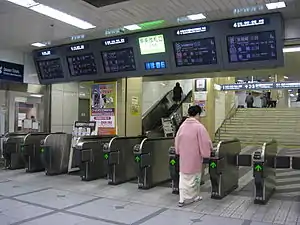 Ticket gates in January 2008 | |
| General information | |
| Location | Nakamura, Nagoya, Aichi Japan |
| Coordinates | 35.1695461°N 136.8838763°E |
| Operated by | Meitetsu |
| Line(s) | Meitetsu Nagoya Main Line |
| Platforms | 3 platforms (with Spanish solution), 2 tracks |
| Connections | Coach services |
| Construction | |
| Structure type | Underground |
| Other information | |
| Station code | NH36 |
| History | |
| Opened | August 12, 1941 |
| Previous names | Shin Nagoya Station (until 2005) |
| Passengers | |
| FY2018 | 151,891 daily |
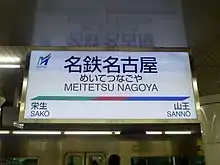
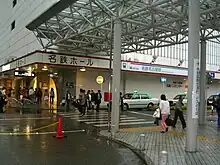
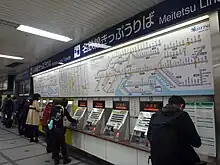

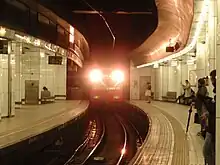

This station is built under the Meitetsu Department Store, therefore the station area is very narrow for the large number of passengers, but it is technically difficult to enlarge the station due to the limited and complicated underground area.[1] Therefore, at this station, passengers' waiting spots are separated by destination. Passengers are required to wait at their spot to go.[2]
The station is adjacent to JR Central's Nagoya Station, the city's central station, and Kintetsu Nagoya Station, the terminal of the Kintetsu Nagoya Line.[3]
Ticket Gates
There are 7 ticket gates at Meitetsu Nagoya Station, including the Central Ticket Gate, West Ticket Gate, South Ticket Gate, North Ticket Gate, East Ticket Gate, New South Ticket Gate and Kintetsu Connection Ticket Gate.
The Central Ticket Gate, West Ticket Gate, and South Ticket Gate are located in the Meitetsu station building, and the North Ticket Gate can be accessed from the Gatewalk Underground Shopping Mall.
The East Ticket Gate and New South Ticket Gate are only for entrance to Platform 4. The East Ticket Gate is near the underground lottery sales kiosk, and the New South Ticket Gate is at the back of the Meitetsu department store underground food section.
The Kintetsu connection ticket gate connects Platform 1 to the Kintetsu Nagoya Station platforms.
 Central Ticket Gate
Central Ticket Gate West Ticket Gate
West Ticket Gate South Ticket Gate
South Ticket Gate North Ticket Gate
North Ticket Gate East Ticket Gate
East Ticket Gate New South Ticket Gate
New South Ticket Gate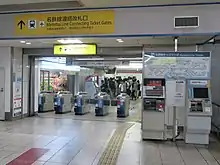 Kintetsu-Meitetsu Connection Ticket Gate
Kintetsu-Meitetsu Connection Ticket Gate
Riding spots
At Meitetsu Nagoya Station, passengers' riding spots are separated by their destinations. Additionally, Meitetsu has two-door trains and three-door trains, therefore passengers are required to wait at the spot with light on.
Track No.1 (for Ichinomiya, Gifu, Iwakura, Inuyama, Shin Kani, Kakamigahara, Tsushima and Saya)
| Spot color | Display | Railway lines | Types of trains | Destination |
|---|---|---|---|---|
| Blue |  | ■ Nagoya | □ Rapid Ltd. Exp. ■ Limited Express ■ Express ■ Semi Express | Meitetsu Ichinomiya Meitetsu Gifu |
| Yellow |  | ■ Nagoya | ■ Local | Meitetsu Gifu |
| Green |  | ■ Inuyama ■ Kakamigahara ■ Hiromi | □ Rapid Ltd. Exp. ■ Limited Express ■ Express ■ Semi Express | Shin Unuma Shin Kani Meitetsu Gifu (via Inuyama) |
| Light Blue |  | ■ Inuayama ■ Kakamigahara | ■ Local | Iwakura Inuyama |
| Purple |  | ■ Tsushima ■ Bisai | ■ Limited Express ■ Express ■ Semi Express ■ Local | Tsushima Saya Yatomi |
- There are only very few local trains for Gifu, so passengers should use local trains for Tsushima or transfer at Sukaguchi.
Track No.2 (for Ichinomiya, Gifu, Inuyama, Shin Unuma, Shin Kani and Saya)
Track No.3 (for Toyohashi, Nishio, Tokoname, Central Japan International Airport, Kōwa and Utsumi)
- These tracks are used only for passengers with seat reservation for a □ μSky Limited Express, □ Rapid Limited Express and ■ Limited Express and for arrival.
Track No.4 (for Higashi Okazaki, Toyohashi, Toyokawa-inari, Nishio, Tokoname, Central Japan International Airport, Kōwa and Utsumi)
| Spot color | Display | Railway lines | Types of trains | Destination |
|---|---|---|---|---|
| Blue |  | ■ Nagoya ■ Nishio ■ Toyokawa | □ Rapid Ltd. Exp. ■ Limited Express ■ Express ■ Semi Express | Toyohashi Kira Yoshida Toyokawa-Inari Toyoake |
| Yellow |  | ■ Nagoya ■ Nishio | ■ Local | Narumi Toyoake Higashi Okazaki |
| Green |  | ■ Tokoname ■ Airport ■ Kōwa ■ Chita | ■ Limited Express □ Rapid Express ■ Express ■ Semi Express | Central Japan International Airport Kōwa Utsumi |
| Light Blue |  | ■ Tokoname ■ Airport ■ Kōwa ■ Chita | ■ Local | Ōtagawa Tokoname Chita Handa |
Transfer
- At Nagoya Station:
- Central Japan Railway Company
- Tōkaidō Shinkansen (for Shin-Yokohama, Tokyo, Kyoto and Shin-Osaka)
- Tōkaidō Line (for Gifu, Ogaki, Obu, Kariya, Gamagori, Toyohashi and Hamamatsu)
- Chūō Line (for Kozoji (transfer to EXPO SITE), Tajimi and Nakatsugawa)
- Kansai Line (for Yokkaichi, Tsu and Kameyama)
- Takayama Line (Limited Express only, for Gero and Takayama)
- Nagoya Seaside Rapid Railway
- Aonami Line (for Kinjō-Futō) – Station number: AN01
- Nagoya Municipal Subway
- Higashiyama Line – Station number: H08
- Sakura-dōri Line – Station number: S02
- Central Japan Railway Company
- At Kintetsu Nagoya Station:
- Kintetsu Railway
- Nagoya Line (for Yokkaichi, Tsu, Ise-Nakagawa, Matsusaka, Iseshi, Toba, Kashikojima and Osaka)
- Kintetsu Railway
History
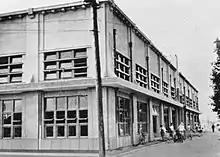
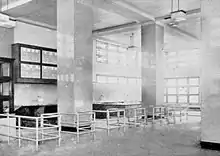
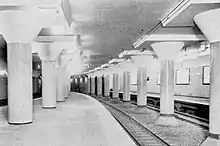
The station opened on August 12, 1941 and was known as Shin Nagoya Station (新名古屋駅, Shin Nagoya eki) until it was renamed in early 2005.[4]
A station refurbishment project including the construction of two new platforms in order to increase the station capacity will be completed by 2027, the year that the maglev Shinkansen is expected to be put into operation.[5]
Adjacent stations
| ← | Service | → | ||
|---|---|---|---|---|
| Nagoya Main Line | ||||
| Kanayama | μSKY Limited Express Rapid Limited Express |
Kōnomiya | ||
| Kanayama | μSKY Limited Express Rapid Limited Express (Through to Inuyama Line) |
Iwakura | ||
| Kanayama | Limited Express | Kōnomiya Sukaguchi (Some trains stop) | ||
| Kanayama | Limited Express (Through to Inuyama Line) |
Iwakura | ||
| Kanayama | Rapid Express | Sukaguchi | ||
| Kanayama | Rapid Express (Through to Inuyama Line) |
Kami Otai | ||
| Kanayama | Express | Sakō | ||
| Kanayama | Semi Express | Sakō | ||
| Sannō | Local | Sakō | ||
References
- "なぜ名鉄名古屋駅は「迷駅」になったのか 「初見殺し」のカオス駅が生まれた理由 - コラム". Jタウンネット. 2019-03-27. Retrieved 2019-09-02.
- "名鉄名古屋" [Meitetsu Nagoya]. www.meitetsu.co.jp. Retrieved 2019-09-02.
- "Urban renewal and utilization of underground space - Focused on Nagoya Station District" (PDF).
- Nagoya Railway. "平成17年1月29日にダイヤ改正を実施" (PDF).
- "名鉄、名古屋駅の4線化を正式発表". nikkei.com (in Japanese). Nikkei Inc. 25 March 2019. Retrieved 2019-09-02.
External links
- Official website (in Japanese)